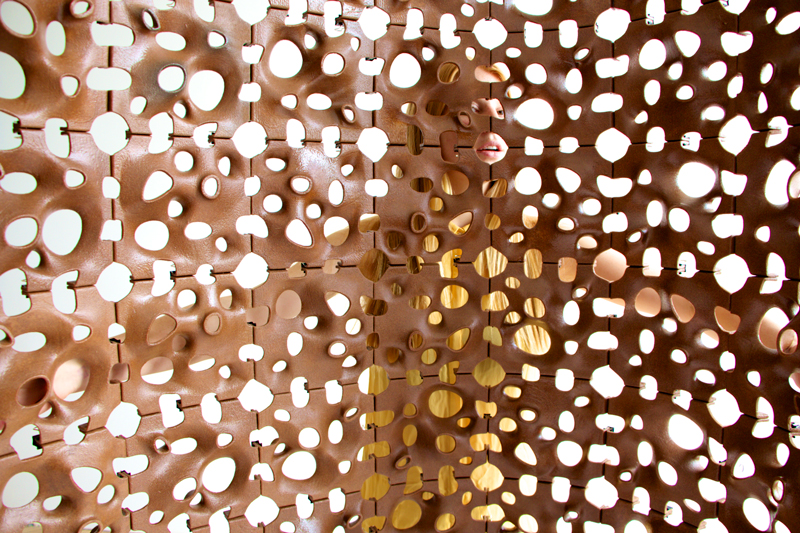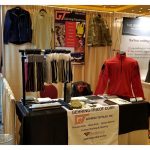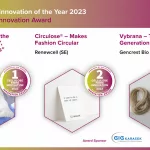Emerging Objects is pleased to announce our new spin-off company, FORUST, growing out of our innovations in 3D printed wood. Created by the founders of pioneering 3D printing companies, Figulo, Boston Ceramics, and Emerging Objects, FORUST is a wood technology company that brings together expertise in design and 21st century manufacturing to promote healthy forests and sustainable interiors. Forust has decades of collective experience in additive manufacturing, material research, and computer aided design. We created FORUST so that we could change the way we manufacture with wood, using methods that are non-destructive to our planet’s ecology. We don’t start with forests, we start with sawdust, and end with forests.
We don’t start with forests, we start with sawdust, and end with forests. The California-based company Forust transforms waste from the timber industry into architectural tiles, panels, blocks and more.
In launching the FORUST project, they partnered with another US AM industry veteran and 3D printing pioneer, Andrew Jeffery, who is the new company’s CEO. Jeffery is the former President of the ceramic 3D Printing companies Figulo and Boston Ceramics. Previously, he was the Director of Ceramic Products at 3D Systems.
At Emerging Objects, San Fratello and Rael have conducted research in binder jetting of several materials leveraging Zcorp/3D Systems binder jetting technology. They have developed unique expertise in how this process can be leveraged to mass-produce end-parts using an unparalleled selection of materials, from ceramics and cement to rubber, sand and even salt, chocolate and tea (yes, tea). They have used this experience to push the limits of materials, design and also, many times, for making social and ethical statements about society and our world in general. Mr. Jeffery is one of the leading experts and innovators for ceramics binder jetting – and ceramics 3D printing in general – in North America.
3D Printed Wood— for the future of our forests
Forust has transformed a subtractive industry that began with trees into an additive industry that begins with sawdust. Sawdust is sourced from the castoffs of the timber industry and manufacturers that work with wood. Using a 3D printer featuring typical inkjet heads, layers of the powdered wood are laid down, held together by a non-toxic and biodegradable binder. Compressed air or brushes remove any excess residue from the final printed object.
We feel really confident in taking lots of things, making them into powder and printing them,” Rael jokes of the trio’s recent foray into new materials, which also include tea, salt and sand. To create their products, the Forust team leverages standard binder jetting 3D printers to deposit layers of fine wood particles with a proprietary binder that Forust claims is as non-toxic as the wood. According to Jeffery, “You could even eat it!” 3D-printed wood can do things that traditional lumber cannot. “You can print very, very thin with certain formulations of wood powder. Sawdust behaves much differently depending on its various sources and particle sizes. You can even have translucency, says Rael.”
Sawdust Screen
The Sawdust Screen is fabricated from 3D printed walnut and the surface retains the layering effect from the additive manufacturing process, which simulates natural wood grain. The screen is comprised of individual 3D printed wood components which are affixed together to form a variably dimensional enclosure and surface.
The Sawdust Screen is inspired by the vessels found in the microscopic analysis of wood anatomy in hardwoods. When viewed from the endgrain, vessels simply appear to be holes in the wood—what are commonly referred to as pores. In a live tree, vessels serve as the pipelines within the trunk, transporting sap within the tree.
In the Sawdust Screen, the vessels serve as an opportunity for visual porosity. The subtle curvature of each vessel accentuates the openings as convex or concave apertures making the screen both a visual and haptic experience.
 Design: Virginia San Fratello, Ronald Rael, Molly Wagner and Victoria Leroux
Design: Virginia San Fratello, Ronald Rael, Molly Wagner and Victoria Leroux
Material: Walnut
Dimensions: Variable
FORUST’s wood 3D printing process by binder jetting can even apply color to surfaces.
Emerging Objects designs and 3D prints environments for the 21st century
Emerging Objects are an independent, creatively driven, 3D Printing MAKE-tank specializing in innovations in 3D printing architecture and building components. The Company designs and 3D prints environments for the 21st century and provides consultation to companies seeking innovative 3D printing solutions to help catapult innovation. EO’s expertise in material development helps to create compelling designs that are unable to be achieved any other way. EO’s production portfolio includes a wide range of additive manufacturing techniques (SLS, FDM, 3DP, LOM + more) and their unique material expertise allows to create objects with unique materials that are not yet widely available in 3D printing.
The products are largely based o the extensive research that Emerging Objects has conducted over the past decades on binder jetting of wood sawdust, leading to geometrically complex, elegantly finished structures, that include tiles, blocks and panels.
Emerging Objects is the creative think-tank run by architects Virginia San Fratello and Ronald Rael. San Fratello is the Chair of the Department of Design at San Jose State University in Silicon Valley and also acts as the Chief Creative Officer at Emerging Objects. Ronald Rael is a Professor and Chair of the Department of Architecture at the University of California Berkeley. At FORUST, San Fratello is the company’s President and Rael is the COO.
FORUST CORPORATION
1933 DAVIS ST, SUITE 299,
SAN LEANDRO, CA 94577, UNITED STATES
+1 (415) 275-1943
[email protected]









